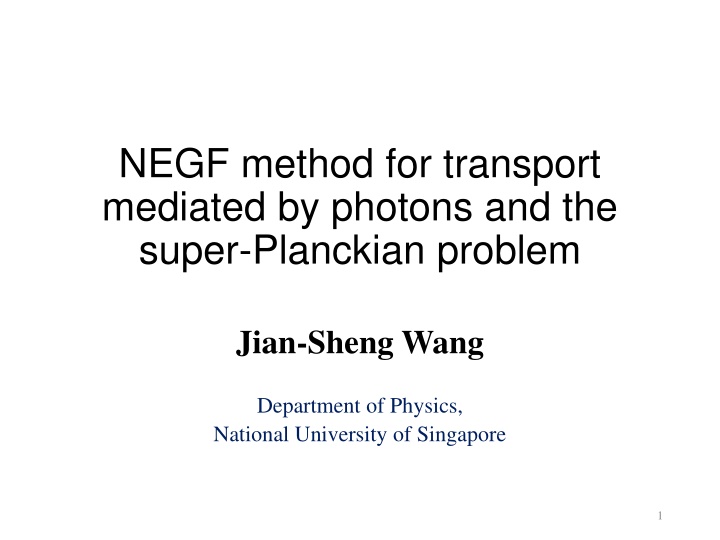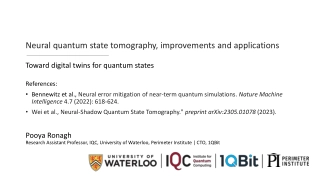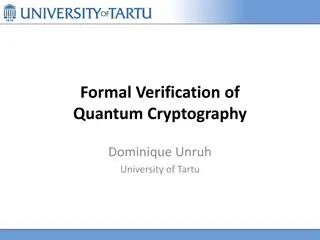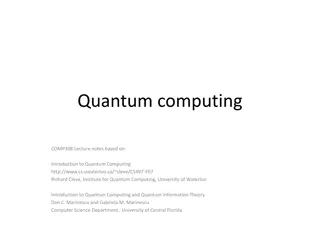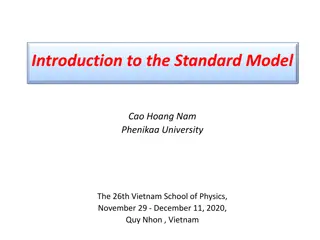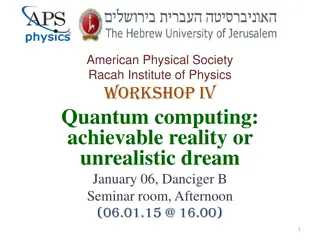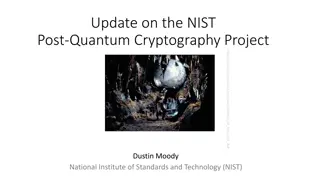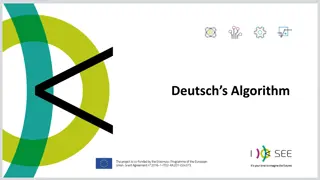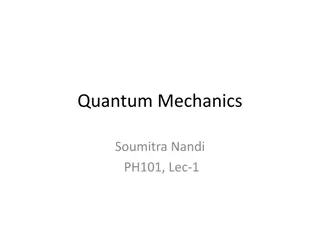Advanced Methods in Transport Phenomena and Quantum Field Theory
Explore cutting-edge research in transport processes mediated by photons, tight-binding models for electron behavior, electron-field interactions, NEGF definitions, fluctuation-dissipation theorem, Dyson equations, and Keldysh equations in the context of quantum field theory and super-Planckian near-field radiation.
Download Presentation

Please find below an Image/Link to download the presentation.
The content on the website is provided AS IS for your information and personal use only. It may not be sold, licensed, or shared on other websites without obtaining consent from the author.If you encounter any issues during the download, it is possible that the publisher has removed the file from their server.
You are allowed to download the files provided on this website for personal or commercial use, subject to the condition that they are used lawfully. All files are the property of their respective owners.
The content on the website is provided AS IS for your information and personal use only. It may not be sold, licensed, or shared on other websites without obtaining consent from the author.
E N D
Presentation Transcript
NEGF method for transport mediated by photons and the super-Planckian problem Jian-Sheng Wang Department of Physics, National University of Singapore 1
Tight-binding model for electrons NEGF theory of energy, momentum, and angular momentum transfer, Meir-Wingreen formulas Applications van der Waals force vs Biot-Savart law Super-Planckian near-field radiation in 2D metals Outline 2
Electron tight-binding model with bath(s) 1 ??? = ? ? ?? system ?<? = ??? <? ??? <? = ?(?) ?? ?? ?? = ?? bath 3
Electron-field interaction, Peierls substitution system ? ?????exp ??/ ?? ? ?? ? ?:vector field bath 4
NEGF definitions A 1 i = = = ( , ; ' ') t r r ( , ) r ( ', ') t r E B A , D t A t A t = A , , , A x y z 1 i = ( , ; ' ') t r r ( ', ') r ( , ) t r D t A t A ( ) = Tr ( ) = r ( ') D t t D D + = = = K r a , D D D D D D D iA 5
Fluctuation-dissipation theorem in thermal equilibrium ( ) ( ) = = + r a r a , ( 1) D N D D D N D D ( ) = a r D D Callen and Welton 1951, Eckhardt 1984 1 = N 1 e ( ; , ') r r D D ( ) = D D 6
Dyson equations ( ) D = + r a D D D 2 v v D = + = + 1 2 D v U c 0 2 = + r r r r r D v v 2 + = ') ( + 2 r ( , '; r r r r ') ( ') U c D t t U t t 0 2 t 3 r r r ( , '', r r ( '', ', '' r r '' '' '') ') d dt t t D t t 1 0 0 0 1 0 0 0 1 r = = j A U 7
Keldysh equation ( ) D = + r a D D D 2 v v D = + = + 1 2 D v U c 0 2 t = + r r r r r D v v = + ( + + ( + r r r a a a D v D v D v D D v D D ) + r a r r a a = +( ) ( ) D I v I ) + + 1 1 r r a a = ( ) ( ) D N v v D = r a environment: = ( ) v N v v 1 r r ( ) v 8
From surface integral to volume integral A 1 = = = ( ) I d dV dV E B E j j t 0 f ( ) = = = F d dV dV A j T ( ) = = = r f + j A N r T d dV dV A j r = + j B f E 1 1 2 1 = + = + 2 2 T EE BB U E B , u u 0 0 0 0 9
Self energy diamagnetic RPA 2 1 e = + = H H H 0 int 4 137 c 0 = = l jk j A j ( ) r H dV c M c A int k l jkl ( ) v v D = + = = 2 r = 1 D 0 i ( ) ' ( ', ) l l ( , ') Tr ( , ') i M G M G , ' l l e 10
Meir-Wingreen formula Kr ger, et al (2012); Strekha, et al, PRA p = I F N d ( ) , = + K J ReTr 1,2, , , 1 F N N 2 0 = + K r K K a ( , ', ) r r F D D F J = = + r p S = p , , ( ) S i i 11
van der Waals force between current-carrying graphene nanostrips nearest neighbor hopping t = 2.7 eV Chemical potential bias, ??= ??= 1eV, electric current 1.2 10 4A. Temperature at 300 K. d ?? ?? ?? ?? 12
Force between two 13 8 armchair graphene with chemical potential biases of 1 eV. Black: fluctuational force; red: additional force due to current (Biot- Savart law). J.-S. Wang and M. Antezza, in preparation. 13
Heat transfer in on 2D metals, super-Planckian problem 1000 K 300 K x y z d 14
Drude model approximation to photon self-energy ? ? ?2?2? ? ??,? ? ? = ??,? ??,? 2?? + ? ?: electron surface density ?: electron effective mass 2? = 1/?: inverse relation time ?: lattice constant (4 a.u.) a 15
Fig. 1. Heat flux between coplanar 2D metals as a function of gap sizes. The materials properties are calculated by the Drude model. The red line is the total heat flux; the blue- and green- dotted lines are results from evanescent waves and propagating waves, respectively. The black-dashed line is the Black-body result given by the Stefan-Boltzmann law with a geometrical view factor F = a/2d, where a = 4 a.u. is the lattice constant and d is the gap size. Some parameters: Lx = 160, Lz = 640, T1=1000 K, T2=300 K w_max = 10*Kb*(T1+T2) q_max = 5/d for total and evanescent q_max = w/c for propagating W_n = 512 a_lat = 4 a.u. Rcut = 1.6
Fig. 2. Spectrum of transmission function as a function of frequency and wavevector with the gap size (a) d = 10 a.u. and (b) d = 10000 a.u. The materials properties are calculated by the Drude model. The red lines in (b) are given by ?/c, which represents the boundary of propagating and evanescent waves. T. Zhu, Y.-M. Zhang, and J.-S. Wang, in preparation.
Acknowledgements Tao Zhu, Tiangong University, Tianjin, China Mauro Antezza, Univ Montpellier, CNRS 18
